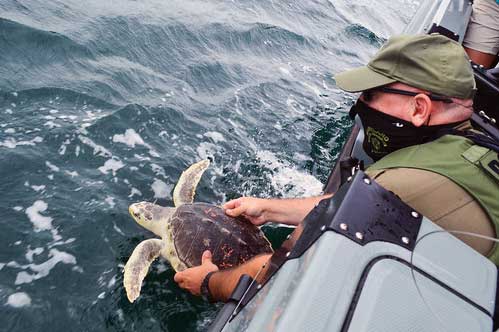Curious about what Chesapeake Bay organisms do in the winter? Here are six examples.

Blue crabs—Our favorite Bay crustaceans head to deeper water and burrow into the muddy and sandy bottom where they stay dormant until water temperatures are near 50 degrees Fahrenheit.
Oysters—These bivalves thrive in winter, although exposure to freezing air is deadly. Known to be at their prime in the “R” months, oysters are open for recreational harvesting from October 1 to March 31 in Maryland.
Turtles—Diamondback terrapins burrow into the mud and hibernate when the water is below about 60 degrees Fahrenheit, but sea turtles such as the loggerhead (commonly found in the Bay during the summer) migrate to warmer waters. As soon as water temperatures dip in the fall, sea turtles and some marine mammals that frequent the Chesapeake Bay are susceptible to cold-stunning or hypothermia. Anyone who sees an unresponsive or lethargic sea turtle or marine animal in Maryland waters or on shore should call the Maryland Marine Mammal Stranding Hotline at (800) 628-9944.
Sea Grass—Submerged aquatic vegetation (SAV) die off by October in the Middle Bay area. The remnants, brown and decayed like corn after a harvest, can often be seen lying on the bottom, since water clarity is generally good during the winter. Spring grasses will return in late March. For species near the Annapolis area, leaves die back in the winter to re-emerge in late spring. Some species return from seeds, some from over-wintering structures called tubers and turions, and some from rhizomes (the horizontal structure below the sediment from which clones grow and beds expand). Some species exploit all three methods of reproduction.
Great Blue Heron—These beautiful birds don’t need to migrate south. Their variable diet permits them to find food around the Bay all winter.
Yellow Perch—During the winter they move into deep holes and channels in the upriver portions of tributaries and creeks, and stage there until late February or early March. Then, when the water temperatures first begin to rise, they move up into headwaters to spawn.